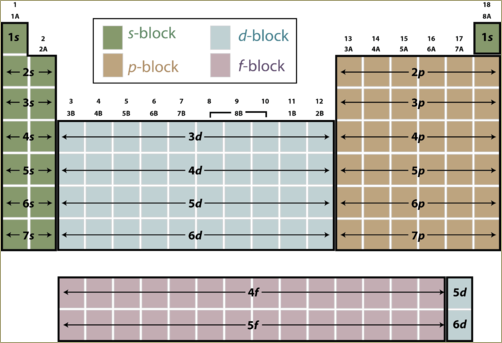
Interpretation:
Two ways of finding the identity of an atom from its electronic configuration needs to be described.
Concept introduction:
The arrangement of electrons in various orbitals of atoms through a shorthand notation is called electron configuration. This helps to keep track of the electrons in an atom. Each subshell is written using the shell number and the subshell letter. The number of electrons in each subshell is indicated with a superscript number.
Answer to Problem 12E
Counting the number of electrons in the electron configuration will help to know the
The valence electronic configuration gives the exact location of the atom on the periodic table. The subscript tells the period number, the subshell letter tells the block and the superscript number tells the row number of that block.
Explanation of Solution
A periodic table can be divided into four zones, s block, p block, d block and f block.

Elements belong to one of these four zones.
Any element located in the s block will have its outermost electron(s) in s subshell. On moving across the periodic table from one element to the next, one additional proton and one additional electron are added, along with one or more neutrons. Each additional electron goes into a specific subshell. If an atom is located in the p block of the table, the last electron is placed into a p subshell. If an atom is located in the d block of the table, the last electron is placed into a d subshell and so on.
Suppose the electron configuration of an element is 1s2 2s2 2p63s2 3p6 3d104s24p5.
- Counting all the superscript numbers one can get the total number of electrons present in an atom of that element. So atomic number = 2 + 2 + 6 + 2 + 6 + 10 + 2 + 5 = 35 By locating this atomic number on the periodic table, one can find the element is bromine.
- By looking at the distribution of electrons in the subshells the last filled subshell can be determined. In this case it is 4p. So the element belongs to p block. The valence electron configuration can help in figuring out the identity of the element. It gives the exact location of the atom on the periodic table. Here 4p5 is the valence electronic configuration. The subscript tells the period number, the subshell letter tells the block and the superscript number tells the row number of that block. Hence the element belongs to period 4 in the p block in row number 5. So the group number is 7A (halogens). The element is bromine.
The valence electronic configuration of each atom can help in figuring out the identity of the element. It gives the exact location of the atom on the periodic table.
Chapter U1 Solutions
Living By Chemistry: First Edition Textbook
Additional Science Textbook Solutions
Chemistry: An Introduction to General, Organic, and Biological Chemistry (13th Edition)
General, Organic, and Biological Chemistry (3rd Edition)
General Chemistry: Atoms First
Chemistry: The Central Science (13th Edition)
Chemistry: A Molecular Approach
Chemistry: A Molecular Approach (4th Edition)
 ChemistryChemistryISBN:9781305957404Author:Steven S. Zumdahl, Susan A. Zumdahl, Donald J. DeCostePublisher:Cengage Learning
ChemistryChemistryISBN:9781305957404Author:Steven S. Zumdahl, Susan A. Zumdahl, Donald J. DeCostePublisher:Cengage Learning ChemistryChemistryISBN:9781259911156Author:Raymond Chang Dr., Jason Overby ProfessorPublisher:McGraw-Hill Education
ChemistryChemistryISBN:9781259911156Author:Raymond Chang Dr., Jason Overby ProfessorPublisher:McGraw-Hill Education Principles of Instrumental AnalysisChemistryISBN:9781305577213Author:Douglas A. Skoog, F. James Holler, Stanley R. CrouchPublisher:Cengage Learning
Principles of Instrumental AnalysisChemistryISBN:9781305577213Author:Douglas A. Skoog, F. James Holler, Stanley R. CrouchPublisher:Cengage Learning Organic ChemistryChemistryISBN:9780078021558Author:Janice Gorzynski Smith Dr.Publisher:McGraw-Hill Education
Organic ChemistryChemistryISBN:9780078021558Author:Janice Gorzynski Smith Dr.Publisher:McGraw-Hill Education Chemistry: Principles and ReactionsChemistryISBN:9781305079373Author:William L. Masterton, Cecile N. HurleyPublisher:Cengage Learning
Chemistry: Principles and ReactionsChemistryISBN:9781305079373Author:William L. Masterton, Cecile N. HurleyPublisher:Cengage Learning Elementary Principles of Chemical Processes, Bind...ChemistryISBN:9781118431221Author:Richard M. Felder, Ronald W. Rousseau, Lisa G. BullardPublisher:WILEY
Elementary Principles of Chemical Processes, Bind...ChemistryISBN:9781118431221Author:Richard M. Felder, Ronald W. Rousseau, Lisa G. BullardPublisher:WILEY





